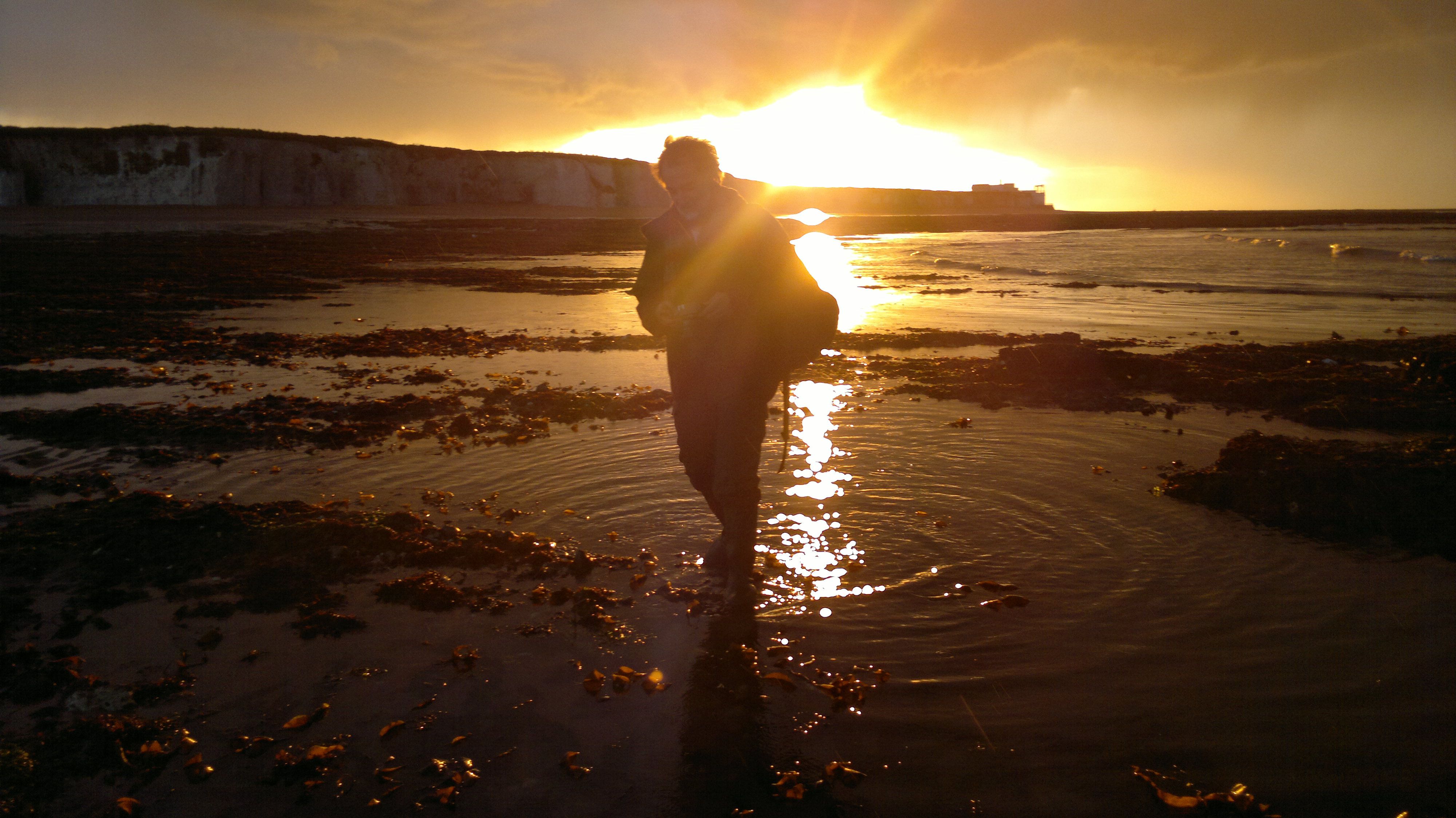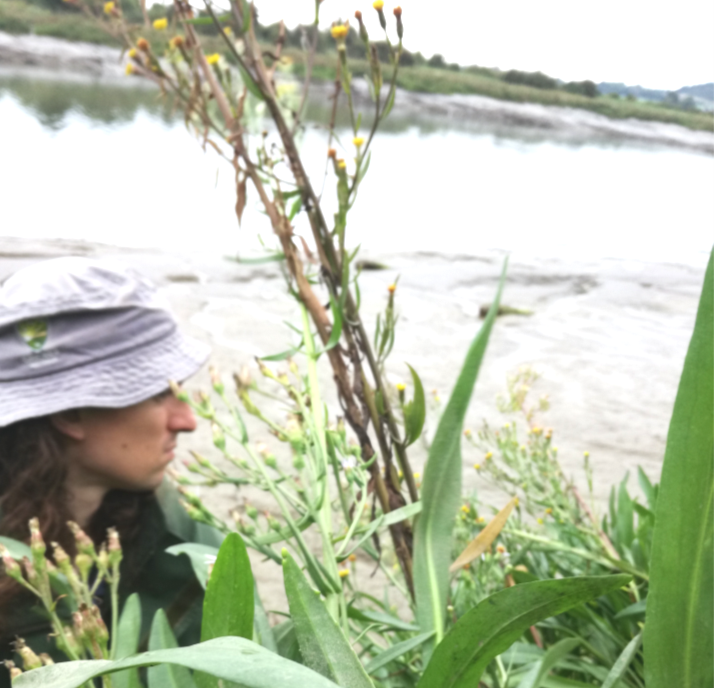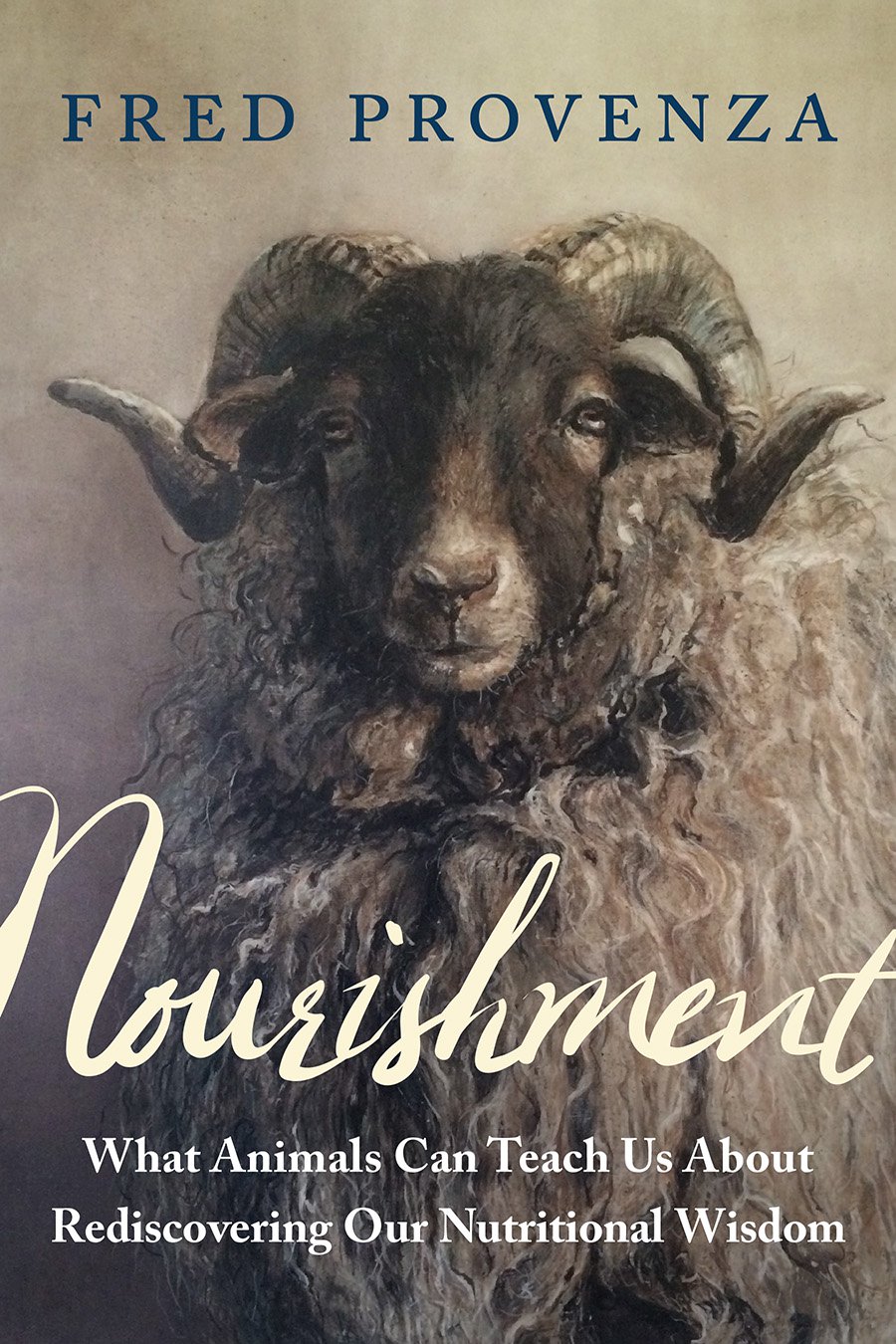I ended the latter with a promise to expand on how the lost connection with landscapes, the roots of our nutrition could be restored by reference to our biology, the feeding behaviour of other species and traditional cultures. That's what I am going to attempt to do here, describing some early thoughts (just getting started!) on how to get back to the sense of being at home on the land experienced by indigenous cultures- how to find our way home through the medium of food. I think I won't finish the task in one blog... but it starts with a story.
Last week I was back at our favourite seaweed harvesting spot, doing a recording for the Ark of Taste series of Radio 4's Food programme with Dan Saladino. We were thinking about traditions of use for the seaweeds, how they have been lost and how what we are doing can be part of restoring them. However, it was more than just thinking and talking-what Dan does so well through the medium of sound is to capture something actually happening and so we were also gathering and tasting as we made our way across the seaweed covered chalk rocks which the outgoing tide had exposed. So there were two of us there, giving focussed attention to the flavours and textures of the various seaweeds- dulse, laver, caragheen, false caragheen, sea lettuce, toothed wrack. The conversation got pretty deep concerning lost connections with landscapes due to the erosion of traditions of use for wild ingredients such as seaweeds. But as we really entered in to the experience of tasting, it dawned on me that this activity itself was an essential part of the process of bringing people back to that deep connection we as a species have lost with the places where we live.

Specifically, just tasting. If you think about it, connections start with an interface- a point of meeting where one thing contacts another and an exchange occurs.
Your ears for example are the point of meeting with another person- assuming it's a friendly exchange, their voice carries words and intonation which, through touching your ears, create a kind of link between what goes on in their body and yours. Other ways- physical contact and gestures for example- also serve to create a connection. And in fact it's very physical- such as when skin contact between mother and child releases a chemical called oxytocin which promotes emotional bonding, and when we hug for longer than a few seconds, or otherwise set one another at ease our bodies synchronise heart beats and breathing. The point of this seeming digression is: a similar kind of intimacy used to exist between people and other species because of food. But we became estranged because we lost the necessary interfaces, the points of contact. And what is the point? What is the point of contact? To foster bonds, intimate bonds, of course...
The bond fostered by contact with plants and land is culture around tending, harvesting, processing, cooking and eating together the fruits of the wild.
But where to start? I felt like we were starting, like a first kiss with an estranged lover, by tasting those seaweeds. I felt alive in that focused state of shared attention with someone else, allowing the point of contact- our sense of taste- to greet and welcome the chemistry of the seaweed into our bodies. The experience of taste and flavour is like a greeting. Somehow, my experience recently feels like just the very start of building an intimate acquaintance with these seaweeds, despite having worked with them for well over 10 years now. In particular the tips of the toothed wrack almost overwhelmed me (Dan too I think) with their sweet, aromatic deliciousness. It must have something to do with the shared nature of the experience (culture!) as well as tasting the seaweeds on location, seconds after harvesting. Although I also think flavour just is more intense just after picking.
The job we at Forager have been engaged in for the last few years has been a big metatask, finding out what is edible, where it is, how to gather it, who wants it- and then organising that supply, predominantly to restaurants. Somehow, this space I am in every week, developing recipes for the Wild Box and focusing on the intimate connection with plants through flavour, feels like a song by Lene Lovich back in the 70s:
''I think we are alone now, there doesn't seem to be anyone around; I think we are alone now, the beating of our hearts is the only sound.'
It feels like responding to the presence of someone who has been near for a long time, finally really noticing, touching, gazing, listening.
Like any kind of intimacy, this is deeply moving and exhilarating. It's also physiological. Like the call and response of conversation, body language, facial expression, where each cue elicits a response which has been hard wired into the system. The dynamics of what happens between mother and child through the maternal bond sheds a lot of light on where this comes from for us and where it leads to. It begins with a mutual gaze and some time in the first few weeks of life, progresses to the point where mothers smile at babies and babies smile back or babies smile at mothers and mothers smile back. It's moving, it's intimate. But it's also hard wired in us for this to happen. Through this first space of intimate contact, we become what we are by a process of unfolding of our potential to relate, potential to form links between us- our bodies- and our surroundings: other people, other species, the landscape. The reciprocity, the dance of smile-smile back progresses into all the other kinds of back and forth social relations which occur in life. Elsewhere in the mother/child relation, another kind of dance, the embryo of our relation to land and food gestates.
As with everything embryonic, it starts in the womb. Food and oxygen, warmth and safety, all are provided by the womb.
Food and oxygen via the umbilical cord through a complex mediation via the mother's vital organs: stomach and lungs acquire food, water and oxygen from outside the mother's body and places them in the mother's blood; the heart pumps that blood which then enters the embryo and developing baby's body through the placenta and umbilical chord. Chemicals derived from whatever the mother has eaten enter the bloodstream of the foetus/ baby. Once the baby is born, the mother's mediation in terms of oxygen ends; it sucks in a first breath of air, thus beginning a life time of direct communion with the earth's atmosphere. I said in the previous blog on this subject 'Roots of Nutrition' that 'accurate selection of nutritious food stuffs in our surroundings is a basic biological capacity common to all living things, as basic as the ability to breathe'. At birth there is no hindrance to this capacity, if the necessary prerequisite is fulfilled: the baby's instinctive seeking out of the mother's breast is triggered by the release of oxytocin, which is triggered by skin to skin contact between mother and baby. So here, bonding is directly linked to instinctive seeking out of a food source. Because breast milk, like blood passed through the placenta, contains the chemistry of what the mother has eaten, it continues to familiarise the baby with whatever the mother has eaten. So mothers continue to mediate the baby's communion with the world through food.
With this as background, let's look now at how taste and flavour provide a tangible link between us and our surroundings when we eat wild plants.
I should say, my inspiration for this train of thought comes from Fred Provenza whose soon to be published book Nourishment (pre-order it here) goes far deeper than I could hope to into the subject. It was a sentence in a paper Fred co-authored which led to my beginning to explore to possibility that my body could know what plants it needed to eat. That sentence was: 'palates connect animals with landscapes through flavour feedback mechanisms'. The basic idea here is that your body has an extended palate, which includes your mouth, nose stomach and the point of delivery in your body of any given chemical, which reads the chemistry of plants you eat and then registers their beneficial effects. If you then later have a particular need for a particular chemical, your extended palate signals that need by giving you an appetite for that plant!
The problem that obstructs this, or rather the means by which this connection fails to form or worse still has been severed, is twofold. Firstly, we are not exposed to nearly as many beneficial phyto- (plant derived) chemicals as we need to be to achieve optimum health. Quite simply,we don't eat lots of wild plants, as our hunter gatherer ancestors would have done, so our bodies can't recognise them as targets for appetite. Secondly, we experience a scrambling of the signalling process of our bodies because of distortions as a result of flavour chemical deceptions in our food and over exposure to certain kinds of foods- mostly refined carbs, especially sweet stuff- which lead to cravings which drown out the still small voice of functional appetite. That said, that still small voice becomes a shout for pregnant ladies who often know very well that they have to eat the strangest things...
Provenza's insights stem from 40 years spent studying grazing animals and the plants on which they feed. He describes their ability to seek out nutrients in landscapes where they are familiar with the plants; he calls this ablity the nutritional wisdom of the body. His thesis however, is that our bodies are as capable as theirs of such wisdom. It seems to me that becoming as familiar with the plants in our landscapes as those grazing animals must provide a means to unlock that wisdom. And of course that's what the Wild Box is intended to do. However, there are limits for us who start as adults. Studies of grazing animals show that familiarity ideally begins in the womb, and continues through the mothers milk and early post weaning exposure to plants. As discussed above, this is because via the placenta and mother's milk, chemicals derived from a diversity of plants become familiar to the foetus' and then the infant's body. I met a couple in Denmark whose experience bears this out. Their son eats raw wild garlic and many other wild plants by the handful. On hearing this I enquired as to how much wild food the mum had eaten whilst pregnant and breast feeding. 'A lot!' came the reply...
Most of us take some time to get accustomed to the strong flavours of wild plants, but this explanation for why that might be goes beyond what we might think, regarding simply needing to get used to a new flavour from an immediate sensory preference point of view. It seems that we may have missed an early opportunity for our bodies to get familiar with beneficial plant chemicals at a much deeper level, learning from the womb, through the breast and through weaning to metabolise them and to recognise their beneficial effects so that our bodies learn to associate that benefit with that plant at a deep and unconscious level which can be communicated to our conscious awareness through appetite for that plant.
Appetite is therefore the key.
But an appetite that has been uncoupled from the distortions which result from an industrial food diet. Quite simply, a distorted appetite creates a desire for something you don't need, at best, and at worst, something which is actually harmful to the body. The way to get appetite back on track, I think, is to start tuning in to what our bodies are saying at a deeper level. That deeper level is simply the level of satisfaction. If we eat something which answers a need we feel satisfied. If what we eat is just answering a craving or is an unthinking grabbing of something to eat because its available, we won't feel satisfied.
For me this insight has me on a journey of tuning in to what my body says about the food I eat.
It started by noting something I had frequently noticed but not given much attention to: my body's response to eating rubbish purchased from service stations when out and about, hungry and minus decent provisions. A pasty. A packet of crisps. You know the sort of thing. What my body repeatedly said to me by means of an uncomfortable, dissatisfied sort of feeling was: why have you put this kind of rubbish inside me again? Around the same time I started paying attention to how my body felt when I had eaten my favourite wild edible plant, wild celery. It seemed to be saying 'Goody, goody, goody! You can put some more of that good stuff in me!'. Somehow this was most strongly expressed via a sensation in my knees shortly after swallowing- explain that as you will...
So on this small foundation I am beginning to notice more such signals- trying to tune into the nutritional wisdom of my own body.
It's there and it's speaking to me- I have no doubt about that. It's just that I need to learn to listen to it, just like I can hear when my body says it's hungry, tired or needs the loo. Or when my gut gets tight because something is causing me to feel edgy... It's just that these signals are perhaps a bit more subtle. And its not just the responses to what I have already eaten- I am listening for cues about what to eat and not to. Again, this needs to be distinguished from appetite for things that can create unhealthy cravings. Although this is probably not black and white and a healthy appetite for cake is by no means precluded as a hard and fast rule- especially if the cake in question contains beneficial things like dried fruit, seeds nuts and spices- on the whole I am anticipating the still small voice of nutritional wisdom to point me less to nutrient poor carb based foods and more to nutrient dense foods. And wild plants in particular. It's early days but I am looking at just what it is I fancy eating and then checking what the outcome is in terms of how my body feels afterwards. The way to really tell if it was genuine appetite or industrial diet induced craving is simply that I feel satisfied by the former but not by the latter. And satisfaction/ dissatisfaction does not seem to be a still small voice. In fact it's quite in your face. Which shows just how pathologically deaf we are to have tuned it out in order to keep eating rubbish... Anyway, just to round this thought off, satisfaction is really the key 'flavour feedback mechanism' in the quote from Fred Provenza, which I will repeat in full here: 'Palates connect animals with landscapes through flavour feedback mechanisms'
Lastly we are back to the beginning, because tasting wild plants and then listening for immediate responses before and after swallowing and then a while later as well. Maybe if it's the first time tasting, seeing how your body responds to the plant the day after, once all the micronutrients have reached where they are needed in your body. Of course your body may be satiated for now- so try again in a few days, a few weeks. Some plants may give us a mega-dose of something we only need once in a while... I may well invite fellow foragers Monica Wilde and Robin Harford to do guest posts further exploring this topic as I know they both have a lot to say on the subject.
So by way of conclusion, pregnant and breastfeeding mothers have a wonderful opportunity to ground their kids in the nutritional wisdom of the body and its capacity to connect us with plants and landscapes through early exposure to wild foods. Please tell all your not-already-foraging friends who are either expecting, trying to conceive or breast feeding to sign up for the Wild Box! And everyone else please join us on this journey, with or without the Wild Box; as we restore a vital connection between ourselves and the land in the ways described above. Let us know your experiences of discovering the nutritional wisdom of your body. With our version of our operating system for this blog page, we can't turn on comments but you are welcome to comment on our YouTube video on this topic, called 'Restoring Vital Connection'. Watch here:


